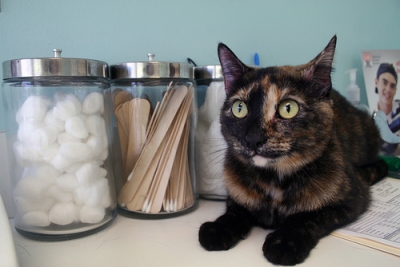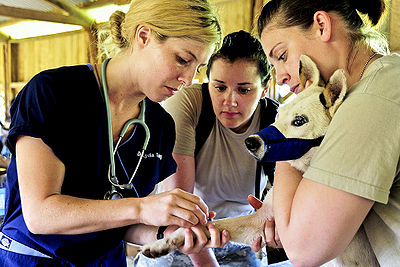
Heimlich Maneuver for Cats
If your cat shows any of the following symptoms, s/he may be choking: pawing the mouth, drooling, coughing, gagging, labored breathing, fainting, becoming unconscious. Your cat might have tried to swallow a foreign object such as a small toy or a bone.
Try to wrap the cat in a towel to avoid getting scratched or bitten. Open the mouth and pull the tongue forward. If you can see the object, try to gently pull it out with a tweezers. If the cat has swallowed string or tinsel, pull at it very gently. If it doesn’t come out, leave it. It may be stuck and pulling on it could do more damage. Take the cat to your veterinarian or emergency clinic immediately.
If the object is not visible try the Heimlich Maneuver. Lay the cat on his/her side, place one hand on the back, the other hand on the belly below the ribs. Push several times sharply on the belly, in and up. Check the mouth to see if the object has come up. Remove it to avoid the cat swallowing it again. Repeat the procedure if necessary until the object comes up.
If the cat is not breathing, try CPR. Get to the veterinarian or emergency clinic immediately in any case to be checked in case of internal injuries.
Heimlich Maneuver for Dogs
Your dog could be choking if s/he is pawing at the face, coughing, eyes are bulging, drooling or gagging. Have a tweezers handy. Using both hands, one on the upper jaw and the other on the lower jaw, try to pry the mouth open If you can see a foreign object, try dislodging it gently with the tweezers. Don’t force it.
If the object cannot be seen or moved, lie the dog on its side with the head lower than the hind quarters. You can use a blanket or pillow to raise the back end. Place your hands around the dog just below the ribcage and press firmly 3-5 times inwards and upwards. Repeat as necessary. As soon as the object is expelled, remove it from the dog’s mouth so it’s not swallowed again.
Or you can stand behind your dog. Place hands on either side of the chest and push inwards and upwards towards the mouth.
Depending on the size of your dog (this sometimes work better with small or medium size dogs) pick up the hind legs and shake to dislodge the object. With large dogs, lift the hind quarter, front paws remain on the floor and tilt forward. Dogs with rounded chests may lie on back and then have the Heimlich Maneuver performed.
If your dog is not breathing, perform CPR as recommended and get to the veterinarian or emergency clinic as soon as possible.
Your dog should be examined after a choking experience by the veterinarian to determine if there are any internal injuries.
News from Dr. Andrew Jones, the internetpetvet.com:
A collaborative effort by Daniel Fletcher, Assistant Professor in Critical Care at Cornell’s College of Veterinary Medicine and Manuel Boller, researcher at the University of Pennsylvania, School of Veterinary Medicine and Center for Resuscitation Science and their teams has resulted in new guidelines for CPR for pets.
1. Firmer chest compressions, and more frequent:
Perform 100-120 chest compressions per minute of one-third to one-half of the chest width, with the animal lying on its side.
2. Less breathing ( ie 30 compressions, then 2 breaths)
Ventilate intubated dogs and cats at a rate of 10 breaths per minute, or at a compression to ventilation ratio of 30 to 2 for mouth-to-snout ventilation.
3. Switch every 2 minutes ( ie in a Veterinary Clinic, with other staff)
Perform CPR in 2-minute cycles, switching the “compressor” each cycle.
4. Specific veterinary drugs to use:
Administer vasopressors every 3–5 minutes during CPR ( these are veterinary medications, such as epinephrine, dopamine)
Related Articles


